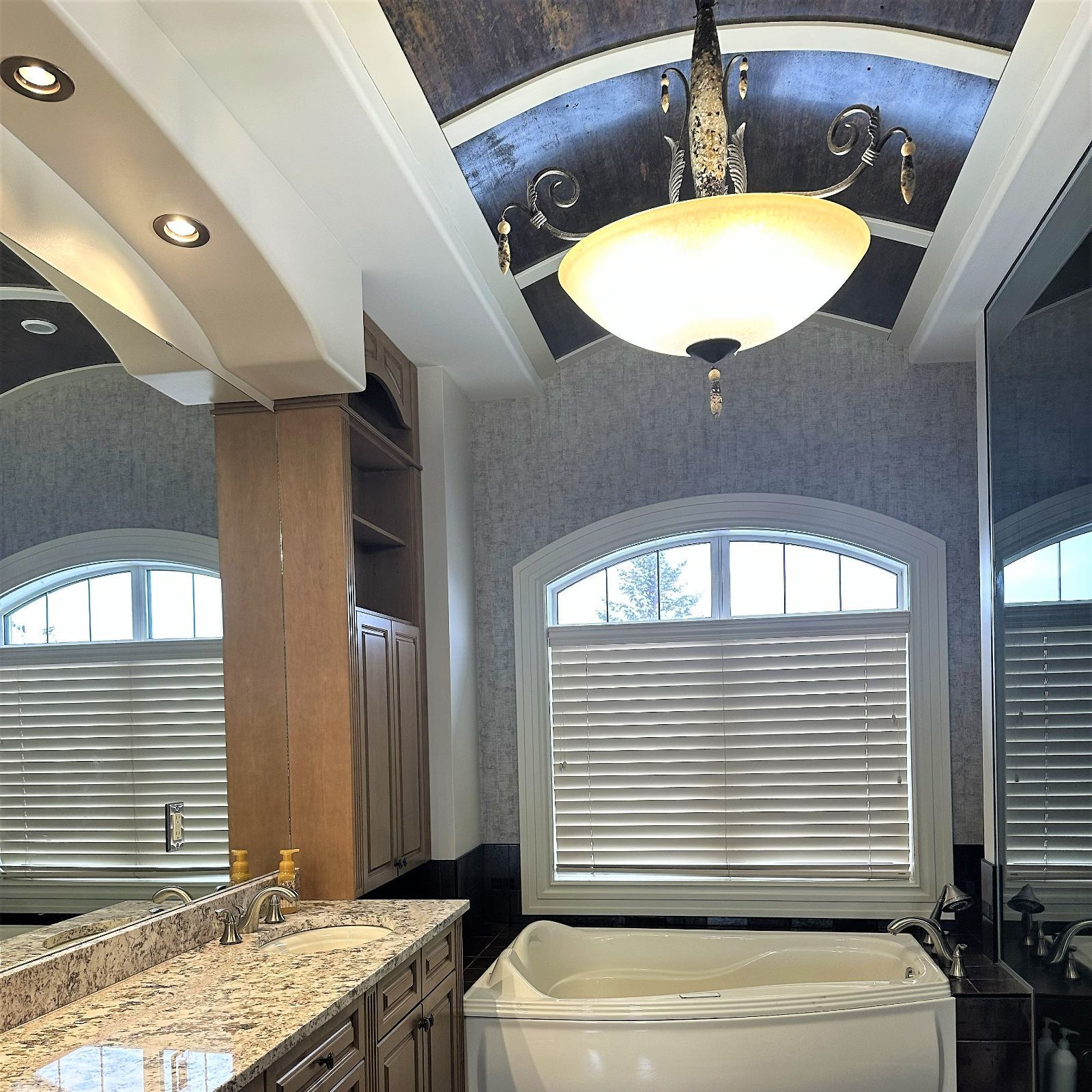By Revive Painting
•
December 18, 2025
Interior painting projects are a major investment when you want to refresh your home. You need to understand the actual costs to plan your budget and avoid surprises in your next painting project. What is the average cost per square foot? The cost of painting per square foot ranges between CAD 2.79 and CAD 8.36. These prices vary because many things affect the final cost beyond your wall size. Wall painting costs between CAD 1.39 and CAD 5.57 per square foot, while ceiling work runs from CAD 1.05 to CAD 3.48 per square foot. Trim and door painting needs more precision and time, so it costs about CAD 2.79 to CAD 6.97 per linear foot. A 1,000 square foot home costs between CAD 3,901.41 and CAD 4,458.75 to paint. Larger homes around 1,500 square feet need between CAD 5,573.44 and CAD 9,056.84. A 2,000 square foot home can cost between CAD 7,663.48 and CAD 11,843.56. Even a single room of about 150 square feet will cost between CAD 766.35 and CAD 1,393.36. How pricing has changed in recent years Paint prices have gone up steadily in the last few years. Raw material costs have risen for paint makers, leading to higher retail prices. Supply chain issues from the pandemic still affect material costs and availability. Labor costs have also increased as skilled workers are in high demand and wages keep rising. Better quality paints with improved durability, coverage, and environmental standards are now common. These premium products cost more upfront but offer better value because they last longer and need fewer touch-ups. Why square footage is only part of the story Square footage helps estimate costs, but it's just the beginning. Your wall's condition plays a big role in the final price. Walls with cracks, holes, water damage, or peeling paint need extra prep work, which adds time and materials. Room complexity matters as much as size. High ceilings, detailed trim work, built-in shelving, or decorative moldings need special attention and techniques that increase labor costs. The number of paint coats varies with colors too. Dark or bright colors usually need multiple coats, especially over lighter shades. Paint quality is a vital cost factor. Cheap paint might save money now but often needs more coats and frequent repainting. Premium paints from trusted brands give better coverage and last longer. Labor makes up the biggest part of interior painting costs —usually 60% to 90% of the total. This covers not just painting but all prep work: moving furniture, protecting floors, cleaning walls, scraping, sanding, and priming. This careful preparation takes time but gives you flawless, lasting results that stand out from DIY work. Breaking Down the Cost of Materials Material costs make up much of your interior painting budget and account for 15-25% of the total project expense. A detailed understanding of these costs helps you plan your next painting project better. Paint types and their price ranges Paint prices vary based on quality, brand, and formulation. You truly get what you pay for with interior paint. Budget latex paints cost around CAD 20.90 to CAD 34.83 per gallon. These paints need more coats and don't last as long. Quality options from Sherwin-Williams and Benjamin Moore range between CAD 69.67 and CAD 111.47 per gallon. They deliver excellent durability and coverage. High-end paints cost from CAD 125.40 to CAD 167.20 per gallon. To name just one example, see Benjamin Moore's Aura Interior Paint at CAD 157.44 per 3.79L can. This ultra-premium line offers unmatched color and longevity. Their Ben Interior Paint costs around CAD 105.88 per 3.79L and strikes a balance between quality and cost. Oil-based paints cost between CAD 34.83 and CAD 97.54 per gallon. These paints are less common now but work great in high-traffic areas and trim work despite their higher VOC content. How many coats are typically needed Paint coat numbers affect your material costs by a lot. Professional painters suggest two coats on most surfaces to get the best color and durability. This rule applies even with premium products because multiple thin coats work better than one thick layer. Some situations need different approaches. Quality paint might need just one coat when you're painting a wall the same color. New drywall needs one coat of primer plus two coats of paint. Dark to light color changes could need up to six coats without proper priming. Textured walls use the same number of coats as smooth ones but need more paint per square foot—sometimes double. Good surface preparation cuts down the coats you'll need, which saves time and money. Additional materials: primer, tape, drop cloths Your project needs several key materials beyond paint. Primer costs about CAD 13.93 per quart and covers around 100 square feet per coat. This investment reduces topcoat needs, especially with stains or big color changes. Painter's tape costs from CAD 11.13 for basic 3M ScotchBlue to CAD 18.10 for premium FrogTape Multi-Surface. Drop cloths protect floors and furniture well. Canvas options are best at CAD 32.03 to CAD 83.59. Plastic sheeting costs less at CAD 19.49 to CAD 32.03 for multi-packs. These extra materials usually cost between CAD 278.67 and CAD 418.01 for DIY projects. Professional painters include these costs in their estimates or add them separately at lower rates than retail. Estimating gallons based on surface area Accurate paint calculations prevent supply runs and waste. One gallon usually covers 300-400 square feet of smooth wall. Textured surfaces need more paint, often covering just 200-300 square feet per gallon. Major paint manufacturers offer online calculators that are a great way to get precise amounts. These tools consider wall size, doors, windows, and coat numbers. A quick method is to divide total square footage by 300-400 to find gallons needed, plus extra for touch-ups. A 1,500 square foot home needs about 8-12 gallons of paint. This amount assumes normal coverage rates and two coats. Note that trim and ceiling paint needs separate calculations because these surfaces have different coverage rates and often use different products. Labor Costs: The Largest Piece of the Puzzle Labor costs make up 75% to 95% of what you'll pay for any interior painting project. Knowing how painters price their work helps you plan your budget and value their expertise. Hourly rates for painters in Saskatoon Recent employment data shows professional painters in our area charge between CAD 18.00 and CAD 33.00 per hour. The typical rate sits at CAD 24.00. Independent surveys paint an even better picture - painters earn CAD 33.27 per hour on average. These rates show how much skill goes into professional painting. The rates keep going up as more people want quality work done. How experience and crew size affect pricing Experience changes labor costs a lot. New painters with 1-3 years of experience charge about CAD 59,233 yearly (around CAD 28.48 per hour). Seasoned painters with 8+ years under their belt earn up to CAD 97,310 yearly (about CAD 46.78 per hour). Yes, it is worth paying more for expertise. Experienced painters work faster and deliver better results with fewer mistakes that could get pricey to fix. The size of the painting crew affects both time and cost. A painter working alone takes 10-16 hours to finish a standard room because they must do each task one after another. A team can knock out the same job in 4-6 hours. Teams might charge more per hour, but they often cost the same or less overall because they finish faster. Time estimates for different room sizes A standard 12×12 bedroom with 8-foot ceilings takes pros 6-10 hours to paint. They spend 2-3 hours on prep work, 1-2 hours cutting in, 2-4 hours rolling, and 1-2 hours cleaning up. Bigger rooms or high ceilings need more time - sometimes 1-2 full days of work. Why prep and cleanup time matters Prep work takes time but it's crucial. Good prep work accounts for about 80% of what makes a paint job great. Painters must move furniture, protect surfaces, clean walls, fix flaws, and tape trim before they open a paint can. Pro painters know that rushing prep work leads to poor results. Paint itself only costs about 20% of your total project - labor makes up the other 80%. The time spent on proper preparation will give a paint job that lasts and looks great, making every dollar spent on labor worth it. Overhead, Profit, and Business Costs Running a successful painting business needs more than just materials and labor. You must understand the financial framework that supports your operations. Many business owners overlook overhead costs, yet these significant expenses affect every square foot price calculation. What overhead includes for painting contractors A painting business has many hidden costs that go far beyond brushes and paint. Monthly overhead makes up about 10% of your total costs. Everything you need to run the business has costs - insurance premiums average CAD 696.68 monthly, office space or storage facilities run about CAD 2,438.38 monthly. Vehicle maintenance and fuel costs typically reach 20% of revenue. Marketing expenses can hit 30% of revenue. Business software subscriptions and administrative staff wages add to these costs. Even small operations need simple overhead like tools, utilities (around CAD 100 monthly), and marketing expenses (about CAD 139.34 weekly). These costs help create accurate estimates that keep your business profitable. Factoring in your own salary as a business owner Many painting contractors make one big mistake - they don't include their compensation in overhead calculations. As owner and operator, you should receive 15% to 18% of your business's total revenue. You likely handle multiple roles - business owner (15% share), salesperson (7-8%), production manager (5-7%), and administrative tasks (3-5%). Each role deserves separate pay. Your business sustainability suffers when you leave out your salary from estimates - you end up working for free. Calculate a company labor rate that covers all costs, including fair compensation. Setting a sustainable profit margin Net profit margins in painting businesses range between 13% and 27%. Poorly managed operations can drop below 13%. A gross profit margin above 45% helps maintain good profitability. The most successful contractors keep labor costs around 40% of revenue with materials at about 15%. Industry experts suggest adding a 15% profit buffer to estimates. This buffer isn't extra - it's vital for your business to last and grow. Your estimates should target at least 15% cash flow as the business owner. This ensures each project properly contributes to overhead costs and reasonable profit. Creating Accurate Estimates for Clients The success of painting businesses depends on creating accurate estimates. Your profits rely on precise quotes. Clients need to trust your painting cost per square foot calculations. Why site visits are essential On-site assessments eliminate guesswork that comes with phone or email estimates. A walkthrough helps you spot vital details like wall damage, complex trim work, and moisture problems that affect your pricing. You can take exact measurements instead of depending on numbers from clients. The difference between 8-foot and 12-foot ceilings adds hundreds more square feet per room. This oversight can get pricey if missed. Site visits build trust with potential clients and show your professionalism right from the start. Using digital tools and calculators New estimating software makes calculations more accurate and cuts down office work. Painters can calculate material quantities, labor needs, and project schedules with these digital solutions. Specialized software makes the job easier than using rulers and calculators. It automatically factors in doors, windows, and multiple coats. These tools boost accuracy by using databases and ground costs, which prevents expensive estimation mistakes. How to present a professional quote A professional estimate should spell out everything in the job: preparation, materials, labor, and cleanup. Your quote must include branding, contact details, and clear terms. This builds credibility with clients looking for interior painting services. Digital tools create polished, consistent documents that showcase your company's professionalism. We are Revive Painting & Wallpaper, Saskatoon's local painters, get a quote from us today. Avoiding underbidding and scope creep Underbidding starts a harmful cycle. Winning jobs but losing money leads to cutting corners and damages your reputation. The solution is to add a 5-15% buffer in estimates for unexpected issues. Clear documentation of included and excluded items helps manage scope creep. A well-laid-out change management process helps evaluate and implement adjustments when needed. Well-documented scope statements with pre-approved clauses protect everyone from misunderstandings. Find the Cost of Your Home Want to know the real cost of refreshing your home's interior? A proper budget calculation based on your space will help you plan your painting project better. Room size and complexity play a key role in determining costs. A standard bedroom (12' x 12') costs CAD 557.34 for walls, CAD 139.34 for ceilings, and CAD 222.94 for baseboards. Larger primary bedrooms (16' x 14') cost more at CAD 696.68 for walls. Kitchen and dining area walls average CAD 766.35, while living rooms (18' x 22') run about CAD 919.62. Your home's condition affects the final price significantly. Wall repairs add CAD 55.73 per hour to your estimate. Crown moldings cost an extra CAD 0.91 per linear foot. Sherwin-Williams and Benjamin Moore's online calculators are a great way to get quick estimates. These tools help you figure out material quantities and professional costs based on your measurements. The full picture depends on preparation needs. Quick identification of wall damage, repairs, and space complexity leads to more accurate pricing. We are Revive Painting & Wallpaper, Saskatoon's local painters. Let us give you a quote today. Our detailed assessment looks at all these factors to give you exact pricing without surprises—making sure your interior painting investment brings both beauty and value.



